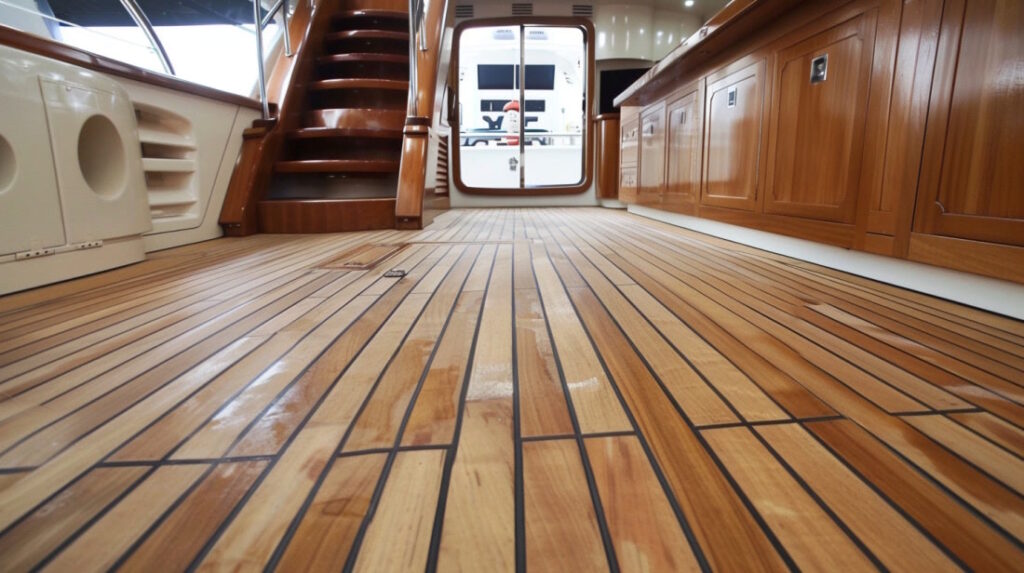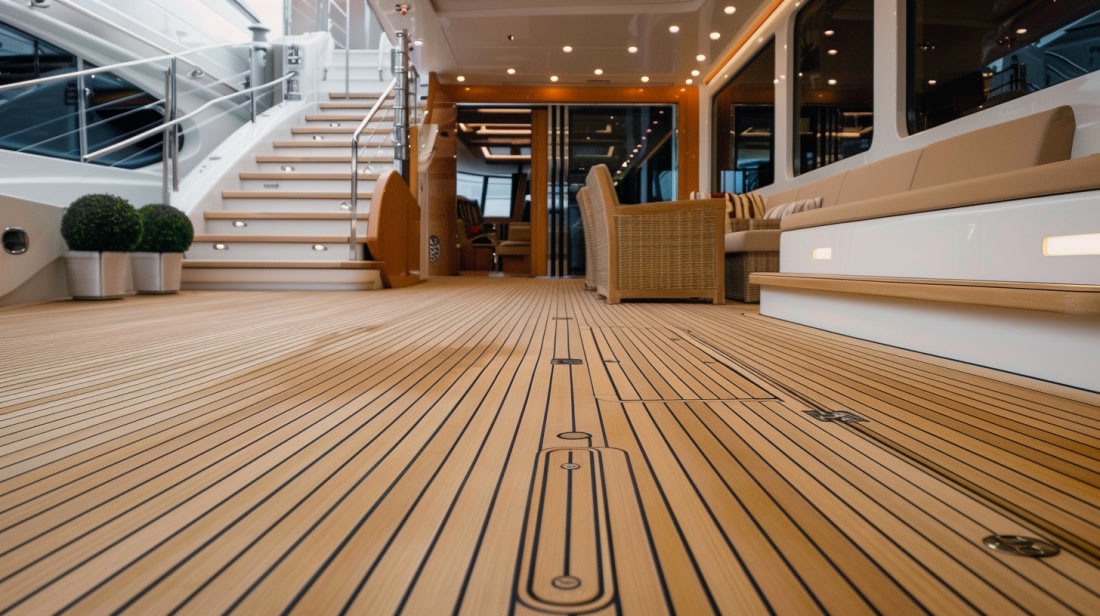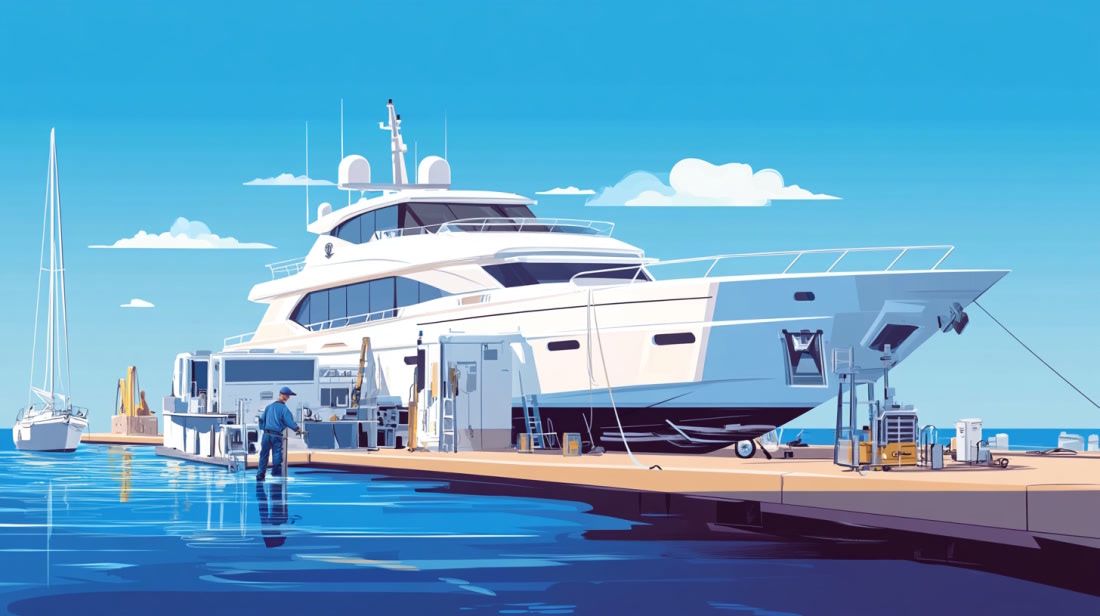When it comes to outfitting a boat, one of the most crucial elements to consider is marine flooring. The right flooring is important for boaters and sailors. Safety, comfort, and looks are all affected by the choice of flooring. Marine flooring is made to endure tough marine conditions such as water exposure, UV rays, and constant foot traffic.
Choosing the right marine flooring involves more than just picking a material that looks good. You need to understand your boat’s specific needs, the activities you do, and the conditions you usually face. Choosing the right option is important when considering different materials like teak or EVA foam.
This article provides a guide to marine flooring, including types, benefits, and maintenance tips. This guide will help you choose the best flooring option for your needs when upgrading or fitting out a new boat.
Types of Marine Flooring
Choosing the right type of marine flooring is crucial for ensuring the safety, comfort, and longevity of your boat’s interior and deck areas. Each type of flooring material offers unique characteristics and benefits, making it important to understand the options available. Here, we explore the most popular types of marine flooring to help you make an informed decision.
Carpet Flooring
Description and Features:
Marine carpet flooring is specifically designed to withstand the rigors of the marine environment. It is typically made from durable, UV-resistant materials that are resistant to mold and mildew.
Pros:
- Soft and comfortable underfoot
- Good sound insulation
- Available in various colors and styles
- Non-slip surface
Cons:
- Can retain water if not properly maintained
- Requires regular cleaning to prevent mold and mildew
- May fade over time due to UV exposure
Vinyl Flooring
Description and Features:
Vinyl flooring is a popular choice for boats due to its durability and water resistance. It comes in sheets, tiles, or planks, often mimicking the appearance of wood or stone.
Pros:
- Waterproof and easy to clean
- Resistant to stains, mold, and mildew
- Durable and long-lasting
- Available in a wide range of designs
Cons:
- Can be slippery when wet, unless textured
- Can feel hard underfoot
- Installation may require professional help
Rubber Flooring
Description and Features:
Rubber flooring provides excellent traction and cushioning, making it a safe and comfortable option for marine environments. It is typically available in tiles or rolls and can be customized to fit specific areas.
Pros:
- Excellent slip resistance, even when wet
- Soft and comfortable underfoot
- Shock absorbent and noise reducing
- Easy to install and replace
Cons:
- Limited color and design options
- Can emit a rubber odor, especially when new
- May degrade over time with prolonged UV exposure
Teak Flooring
Description and Features:
Teak flooring is a traditional and luxurious choice for boats, known for its natural beauty and resilience. It is often used on high-end yachts and classic vessels.
Pros:
- Stunning natural appearance
- High durability and longevity
- Naturally resistant to water, mold, and pests
- Provides excellent grip, even when wet
Cons:
- Expensive compared to other options
- Requires regular maintenance and oiling
- Can be difficult to install
EVA Foam Flooring
Description and Features:
EVA (ethylene-vinyl acetate) foam flooring is a modern option that offers a high level of comfort and customization. It is lightweight, easy to install, and comes in a variety of colors and patterns.
Pros:
- Extremely comfortable and cushioned
- Excellent slip resistance
- Lightweight and easy to install
- UV resistant and durable
Cons:
- Can be prone to damage from sharp objects
- May not be as durable as other options
- Requires careful cleaning to avoid damage
Each type of marine flooring has its own set of advantages and considerations. By understanding the unique features of each, you can choose the best flooring option that meets your specific needs and preferences, ensuring your boat remains safe, comfortable, and visually appealing.
Benefits of Marine Flooring
Selecting the right marine flooring for your boat provides several key benefits that enhance safety, comfort, aesthetics, and maintenance. Here are the primary advantages of investing in high-quality marine flooring:
Safety
Slip Resistance:
Marine flooring is designed to offer excellent slip resistance, crucial for preventing accidents on wet and moving surfaces. Many materials, such as rubber and EVA foam, provide textured surfaces that ensure a firm grip even in wet conditions.
Durability in Wet Conditions:
Marine flooring materials are specifically chosen for their ability to withstand constant exposure to water. They resist water absorption, preventing the growth of mold and mildew and maintaining their integrity over time.
Comfort
Cushioning and Impact Absorption:
Certain types of marine flooring, such as carpet and EVA foam, provide a cushioned surface that absorbs impact. This is particularly beneficial for long periods of standing or walking on the deck, reducing fatigue and improving overall comfort.
Temperature Regulation:
Some marine flooring materials can help regulate temperature, providing a cooler surface underfoot in hot weather and a warmer surface in cooler conditions, enhancing the comfort of your boating experience.
Aesthetics
Enhancing the Look of the Boat:
Marine flooring comes in a variety of materials, colors, and patterns, allowing you to customize the look of your boat. Whether you prefer the classic elegance of teak or the modern appeal of vinyl or EVA foam, the right flooring can significantly enhance your boat’s visual appeal.
Matching Interior and Exterior Designs:
With so many options available, you can choose marine flooring that complements both the interior and exterior design of your boat, creating a cohesive and stylish appearance.
Ease of Maintenance
Simple Cleaning Routines:
Most marine flooring options are designed to be low-maintenance and easy to clean. Vinyl and rubber flooring, for example, can be quickly wiped down, while marine carpets are treated to resist stains and moisture, making them easier to keep clean.
Durability and Longevity:
Investing in high-quality marine flooring means you won’t have to replace it frequently. Durable materials like vinyl and teak can withstand heavy use and harsh marine conditions, providing long-lasting performance and reducing the need for frequent replacements.
By understanding and prioritizing these benefits, you can make a well-informed decision that enhances your boating experience. The right marine flooring not only improves safety and comfort but also adds to the aesthetic appeal and ease of maintaining your boat, ensuring you enjoy many years on the water.

Choosing the Right Marine Flooring
Selecting the appropriate marine flooring for your boat involves considering various factors that align with your specific needs and preferences. Here’s a guide to help you make the best choice for your vessel.
Factors to Consider
Type of Boat:
The type of boat you own can significantly influence your flooring choice. Larger vessels like yachts may benefit from luxurious options like teak, while fishing boats or smaller recreational boats might be better suited for practical, easy-to-clean materials like vinyl or rubber.
Usage:
Consider how you use your boat. If your activities include fishing, watersports, or frequent entertaining, choose a flooring material that can handle high traffic, spills, and equipment impact. For instance, rubber and EVA foam are ideal for high-activity areas due to their durability and comfort.
Climate and Environment:
The climate where you primarily use your boat is another important factor. In hot climates, materials that resist heat absorption and UV damage, like EVA foam, are preferable. In wetter environments, waterproof and mold-resistant materials, such as vinyl, are essential.
Budget:
Your budget will play a crucial role in your decision. High-end options like teak offer unparalleled beauty and durability but come at a premium price. More affordable choices like carpet or vinyl can still provide excellent performance and aesthetics without breaking the bank.
Maintenance Requirements:
Consider how much time and effort you’re willing to invest in maintaining your flooring. Some materials, like teak, require regular oiling and care, while others, like vinyl and rubber, are low-maintenance and easy to clean.
Comparison of Different Flooring Types
Carpet:
- Pros: Soft, comfortable, good insulation.
- Cons: Prone to water retention, requires regular cleaning.
Vinyl:
- Pros: Waterproof, easy to clean, versatile designs.
- Cons: Can be slippery, may require professional installation.
Rubber:
- Pros: Slip-resistant, shock absorbent, easy to install.
- Cons: Limited design options, can emit odor.
Teak:
- Pros: Luxurious, durable, naturally resistant to water and pests.
- Cons: Expensive, high maintenance.
EVA Foam:
- Pros: Comfortable, UV resistant, easy to install.
- Cons: Can be easily damaged by sharp objects, requires careful cleaning.
Tips for Making the Best Choice
Evaluate Your Needs:
Make a list of your priorities, such as comfort, durability, aesthetics, and maintenance, and weigh each type of flooring against these criteria.
Sample Testing:
If possible, test samples of different flooring materials to see how they feel underfoot and how they handle water and wear. This can give you a better idea of what will work best on your boat.
Seek Expert Advice:
Consult with marine flooring experts or other boat owners to get insights and recommendations based on real-world experiences.
Consider Future Use:
Think about how your boating needs might evolve. Investing in a slightly more durable or versatile option now could save you time and money in the future.
Installation Process
Installing marine flooring can significantly enhance the functionality and aesthetics of your boat. Whether you choose to undertake the installation yourself or hire a professional, understanding the process can help ensure a successful outcome. Here’s a step-by-step guide to the marine flooring installation process.
Preparation
Measuring the Area:
Accurate measurements are critical. Use a tape measure to carefully measure the length and width of the area where the flooring will be installed. For irregular shapes, create a template using cardboard or heavy paper to ensure a precise fit.
Preparing the Surface:
Before installation, the surface must be clean, dry, and smooth. Remove any old flooring materials, adhesives, and debris. Sand down any rough spots and repair any damage to the boat’s deck. A clean, smooth surface ensures the new flooring adheres properly and looks its best.
Installation Techniques
DIY vs. Professional Installation:
DIY Installation:
- Cost-effective and satisfying, but requires time and attention to detail.
- Suitable for those with some experience in DIY projects.
- Professional Installation:
- More expensive but ensures a high-quality finish.
- Ideal for complex installations or high-end materials like teak.
Post-Installation Care
Ensuring Longevity:
- Allow sufficient time for the adhesive to cure before using the area.
- Follow manufacturer recommendations for cleaning and maintenance.
Regular Maintenance:
- Clean the flooring regularly to prevent dirt buildup.
- Inspect for any signs of wear or damage and address them promptly.
By understanding the installation process and taking the time to prepare properly, you can ensure your marine flooring is installed correctly, providing durability and enhancing the overall appearance of your boat. Whether you choose to do it yourself or hire a professional, these steps will guide you to a successful installation.
Maintenance and Care
Proper maintenance and care of marine flooring are essential to ensure its longevity, functionality, and appearance. Here’s a comprehensive guide to help you keep your marine flooring in top condition.
Regular Cleaning Routines
Daily Cleaning:
- Sweep and Vacuum:
Regularly sweep or vacuum the flooring to remove dirt, sand, and debris that can cause wear and tear. - Spot Clean:
Immediately clean up spills and stains to prevent them from setting. Use a damp cloth and mild soap for most stains.
Weekly Cleaning:
- Mopping:
For vinyl, rubber, and EVA foam flooring, use a damp mop with a mild detergent. Avoid soaking the floor; excessive water can damage the adhesive and underlying surfaces. - Brushing:
For carpeted areas, use a soft brush to lift dirt and restore the pile.
Monthly Cleaning:
- Deep Clean:
Perform a more thorough cleaning using a marine-grade cleaner. For teak, use a teak cleaner to maintain its natural oils and prevent graying. - Inspect and Repair:
Check for any signs of damage, such as loose edges or wear spots, and address them promptly.
Products to Use and Avoid
Recommended Products:
- Mild Detergents:
Use non-abrasive, marine-safe cleaners specifically formulated for your flooring type. - Marine-Grade Cleaners:
These cleaners are designed to handle the harsh marine environment and are safe for use on boat surfaces. - Teak Oil and Cleaners:
For teak flooring, use products designed to maintain its natural oils and appearance.
Products to Avoid:
- Harsh Chemicals:
Avoid bleach, ammonia, and other harsh chemicals that can damage the flooring material and cause discoloration. - Abrasive Cleaners:
Steer clear of abrasive pads and brushes that can scratch the surface of your flooring. - Excessive Water:
Avoid using too much water, especially on carpet and foam flooring, as it can lead to mold, mildew, and adhesive failure.
Addressing Common Issues
Stains:
- General Stains:
Use a mild detergent and a soft cloth to gently clean the stained area. For tougher stains, use a marine-grade cleaner. - Oil and Grease:
Blot the stain with a paper towel, then clean with a degreasing agent specifically designed for marine use. - Mold and Mildew:
For mold and mildew, use a mixture of water and white vinegar or a marine-grade mold remover. Ensure the area is well-ventilated and dry after cleaning.
Damage:
- Scratches and Scuffs:
For minor scratches on vinyl or rubber, use a repair kit designed for the specific material. For deeper scratches on teak, light sanding followed by oiling can restore the surface. - Tears and Rips:
For carpet and foam, patch kits are available to repair small tears. For more extensive damage, consider professional repair or replacement.
Long-Term Care
Preventative Measures:
- Protective Mats:
Use protective mats in high-traffic areas to reduce wear and tear. - Furniture Pads:
Place pads under furniture legs to prevent indentations and scratches. - Shade and Covers:
Use boat covers and shades to protect flooring from UV damage when not in use.
Routine Inspections:
- Monthly Inspections:
Regularly inspect the flooring for signs of wear, damage, or moisture issues. Early detection can prevent more significant problems. - Seasonal Maintenance:
At the start and end of the boating season, conduct a thorough inspection and perform any necessary maintenance tasks to prepare the flooring for varying conditions.
Professional Services:
- Periodic Professional Cleaning:
Consider hiring a professional cleaning service annually to deep clean and maintain your flooring. - Expert Repairs:
For significant damage or wear, professional repair services can ensure the flooring is restored correctly.
By following these maintenance and care guidelines, you can extend the life of your marine flooring, maintain its appearance, and ensure it performs well in the demanding marine environment. Regular care not only preserves the flooring but also enhances the overall safety and comfort of your boating experience.
Cost Considerations
When choosing marine flooring, understanding the associated costs is crucial to making an informed decision that fits your budget. The total cost involves not only the price of the material itself but also installation, maintenance, and long-term value. Here’s a detailed look at the cost considerations for marine flooring.
Price Range for Different Types of Marine Flooring
Carpet Flooring:
- Material Cost:
- Low-end: $1 – $2 per square foot
- High-end: $3 – $5 per square foot
- Installation Cost:
- DIY: Minimal (cost of tools and adhesive)
- Professional: $2 – $4 per square foot
Vinyl Flooring:
- Material Cost:
- Low-end: $2 – $3 per square foot
- High-end: $5 – $7 per square foot
- Installation Cost:
- DIY: Moderate (cost of tools, adhesive, or peel-and-stick vinyl)
- Professional: $3 – $5 per square foot
Rubber Flooring:
- Material Cost:
- Low-end: $3 – $4 per square foot
- High-end: $6 – $8 per square foot
- Installation Cost:
- DIY: Low (typically easy to install, some adhesive needed)
- Professional: $3 – $6 per square foot
Teak Flooring:
- Material Cost:
- Low-end: $8 – $12 per square foot
- High-end: $15 – $20 per square foot
- Installation Cost:
- DIY: High (requires precise cutting and adhesive)
- Professional: $8 – $12 per square foot
EVA Foam Flooring:
- Material Cost:
- Low-end: $4 – $5 per square foot
- High-end: $7 – $10 per square foot
- Installation Cost:
- DIY: Low (peel-and-stick, minimal tools needed)
- Professional: $2 – $4 per square foot
Cost vs. Benefits Analysis
Carpet Flooring:
- Pros:
- Low initial cost
- Comfortable and insulating
- Cons:
- Higher maintenance costs due to potential for mold and mildew
- May require more frequent replacement
Vinyl Flooring:
- Pros:
- Mid-range cost
- Durable and easy to maintain
- Cons:
- Can be slippery if not textured
- Installation might require professional help
Rubber Flooring:
- Pros:
- Mid to high initial cost
- Excellent durability and slip resistance
- Cons:
- Limited design options
- May need professional installation for large areas
Teak Flooring:
- Pros:
- High initial cost
- Luxurious and highly durable
- Cons:
- High maintenance costs
- Requires professional installation for best results
EVA Foam Flooring:
- Pros:
- Mid-range cost
- Comfortable and easy to install
- Cons:
- Less durable than other options
- Prone to damage from sharp objects
Long-Term Value and Investment
Durability:
- Investing in durable materials like teak or high-quality vinyl can save money in the long run by reducing the need for frequent replacements.
Maintenance Costs:
- Consider the ongoing maintenance costs associated with each type of flooring. While carpet and teak may have higher maintenance costs, materials like vinyl and rubber typically require less upkeep.
Resale Value:
- High-quality flooring can enhance the resale value of your boat. Luxury materials like teak can make your vessel more attractive to potential buyers.
Comfort and Safety:
- Investing in flooring that provides good comfort and safety, such as EVA foam or rubber, can improve your boating experience and potentially reduce the risk of accidents.
Eco-Friendliness:
- Consider the environmental impact and potential long-term benefits of choosing eco-friendly flooring options, which may also influence future regulations and resale value.
By carefully evaluating these cost considerations, you can select marine flooring that not only fits your budget but also meets your needs for durability, aesthetics, and maintenance. This balanced approach ensures that you make a wise investment, providing lasting value and enhancing your boating experience.
Conclusion
Choosing the right marine flooring is a critical decision that impacts the safety, comfort, aesthetics, and maintenance of your boat. With a variety of options available, each with its own set of advantages and considerations, it’s essential to carefully evaluate your specific needs and preferences.
Marine flooring types such as carpet, vinyl, rubber, teak, and EVA foam offer distinct benefits. Carpet provides comfort and insulation, vinyl offers durability and easy maintenance, rubber ensures slip resistance and cushioning, teak delivers luxury and longevity, and EVA foam provides a comfortable and lightweight solution.
Understanding the benefits of marine flooring, such as slip resistance, durability, comfort, aesthetics, and ease of maintenance, can guide you in making an informed decision. Moreover, considering factors like the type of boat, usage, climate, budget, and maintenance requirements will help you select the most suitable flooring option.
The installation process, whether DIY or professional, involves careful preparation and precise execution to ensure a high-quality finish. Regular maintenance and care are crucial to prolonging the life of your flooring, preserving its appearance, and ensuring optimal performance.
Cost considerations, including the initial price, installation expenses, maintenance costs, and long-term value, are important to weigh when choosing marine flooring. Investing in high-quality, durable materials can save you money in the long run and enhance the resale value of your boat.
By following this comprehensive guide, you can confidently choose marine flooring that meets your needs and enhances your boating experience. A thoughtful selection and proper care will ensure that your marine flooring remains a valuable and attractive part of your vessel for many years to come. Enjoy the peace of mind and satisfaction that comes with knowing your boat is equipped with the best flooring for your maritime adventures.
FAQ: Marine Flooring
1. What is the best type of marine flooring for my boat?
- The best type of marine flooring depends on your specific needs, including the type of boat, usage, climate, and budget. Vinyl is popular for its durability and ease of maintenance, while teak offers luxury and longevity. Rubber and EVA foam are excellent for slip resistance and comfort.
2. How do I maintain my marine flooring?
- Regular cleaning is essential for maintaining marine flooring. Sweep or vacuum to remove debris, mop with a mild detergent for vinyl and rubber, and use specialized cleaners for teak. Address spills and stains promptly and perform deeper cleaning monthly.
3. Can I install marine flooring myself, or should I hire a professional?
- DIY installation is possible for many types of marine flooring, especially peel-and-stick options like EVA foam. However, professional installation ensures a high-quality finish and is recommended for complex materials like teak or larger vinyl sheets.
4. How much does marine flooring cost?
- The cost varies widely depending on the material. Carpet ranges from $1-$5 per square foot, vinyl from $2-$7, rubber from $3-$8, teak from $8-$20, and EVA foam from $4-$10. Installation costs are additional and vary by material and complexity.
5. Is marine flooring waterproof?
- Most marine flooring options are designed to be water-resistant or waterproof. Vinyl, rubber, and EVA foam are excellent for water resistance, while teak is naturally resistant to water due to its high oil content.
6. How long does marine flooring last?
- The lifespan of marine flooring depends on the material and maintenance. High-quality vinyl and teak can last many years with proper care, while carpet and EVA foam may need more frequent replacement, especially in high-traffic areas.
7. What should I consider when choosing marine flooring?
- Consider the type of boat, usage (e.g., fishing, entertaining), climate, budget, and maintenance requirements. Evaluate the benefits and drawbacks of each material, such as comfort, slip resistance, durability, and aesthetics.
8. Can marine flooring improve the resale value of my boat?
- Yes, high-quality marine flooring can enhance the resale value of your boat. Luxurious materials like teak or well-maintained vinyl flooring make your boat more attractive to potential buyers.
9. Is marine flooring environmentally friendly?
- Some marine flooring options are more eco-friendly than others. Look for materials that are recyclable or made from sustainable sources, such as certain types of vinyl or teak certified by the Forest Stewardship Council (FSC).
10. How do I choose the right color and design for my marine flooring?
- Choose colors and designs that complement your boat’s interior and exterior. Consider practical aspects, such as lighter colors showing dirt more easily, and opt for patterns that provide a non-slip surface.
These FAQs should help address common concerns and guide you in making informed decisions about marine flooring for your boat. If you have any other questions, feel free to ask!





